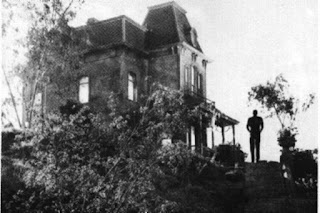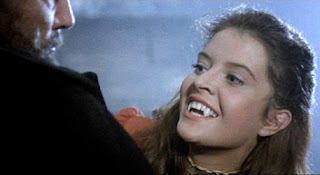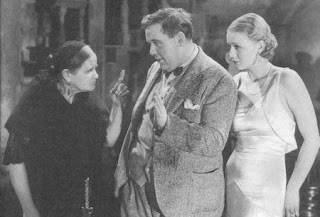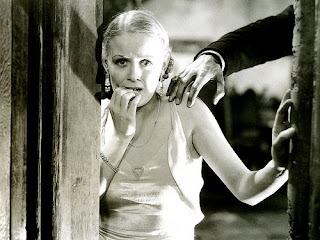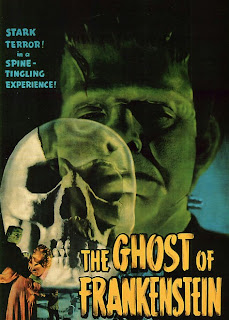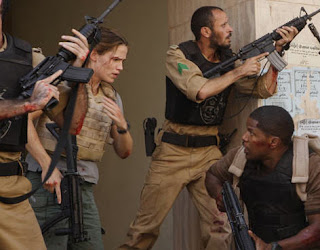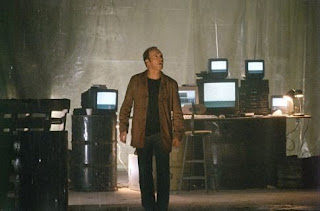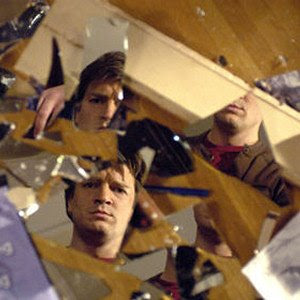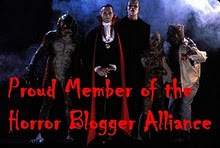The Wolf Man was the last addition to the Universal Monster Pantheon that truly impacted pop culture. Like the Universal's Dracula and Frankenstein's Monster, and like Kharis the Mummy, the Universal Wolf Man became the prototype for most werewolf literature and movies that have beee released since its debut in 1941. However, the Wolf Man is has always been something of a poor stepchild among the Universal Monsters, not even receiving sequels of his own but instead serving as second banana to the 1940s follow-ups to "Dracula" and the two Frankenstein films from the 1930s.

And this short-shrift treatment continues through to this very day. The Wolf Man was considered such a secondary character that his films weren't even included in one set, but instead spread across three Legacy Collections, with only the first Wolf Man sequel included in this set where it properly belongs ("Frankenstein Meets the Wolf Man") and the others being included in "Dracula: The Legacy Collection" ("House of Dracula") and "Frankenstein: The Legacy Collection" ("House of Frankenstein").
It's rather a shame, because, despite the fact that the adventures of Larry Talbot, the reluctant and guilt-ridden monster who is desperately seeking a cure for his curse, were used mostly by Universal to promote re-released other films, they come across better when viewed in context with each other instead of the other films. (For example, if you haven't seen "Frankenstein Meets the Wolf Man," you're going to wonder what the heck happened between the end of "Son of Frankenstein" and the opening of "House of Frankenstein"; how DID the Monster escape his apparent fiery death and end up in an ice floe? (Okay, so the answer doesn't make a whole lot of sense, but at least there IS an answer if you've seen the movie included in this set, and knowing how the story threads fit together makes all the films that much stronger.
The fact the Wolf Man is treated as a secondary property is further shown by the set itself, which is by far the weakest entry in the Legacy Collection series. It's not because the movies aren't good--they're excellent--but it's because half the content has nothing to do with the Wolf Man.
The only Wolf Man films in the set that are properly Wolf Man movies are "The Wolf Man" and the first of the three sequels (or four if you count "Abbott and Costello Meet Frankenstein"), the aforementioned "Frankenstein Meets the Wolf Man." The other two movies are "Werewolf of London," Universal's first attempt at bringing werewolves to the silver screen and "She-Wolf of London," a gothic drama that has absolutely nothing to do with the Wolf Man (and barely anything to do with werewolves). But, since they had to find enough content to justify the set, the editors just threw in whatever werewolvery they could find. (And, frankly, no one even bothered to tell the marketing department to fix the sell copy on the back of the "The Wolf Man Legacy Collection" box, as it features the same boilerplate phrases from the rest of the sets... and it describes a 1935 film as one of "three timeless sequels" to a film released in 1941.
Sloppiness at the marketing department and little respect for the poor, fleabitten Larry Talbot aside, this is still a set that lovers of classic horror films should have as part of their DVD collection.
The Wolf Man (1941)
Starring: Lon Chaney Jr., Claude Rains, Evelyn Ankers, Maria Ouspenskaya, Warren William, and Bela Lugosi
Director: George Waggner
Steve's Rating: Seven of Ten Stars
Engineer Larry Talbot (Chaney) returns to his ancestral home and reconnects with his roots... only to be bitten by a werewolf and find himself cursed. Will he manage to find a cure for a malady that no one in the modern world believes in before he kills someone he loves?

"The Wolf Man" isn't the first werewolf movie--I think that was Universal's "Werewolf of London"--but it's the one that brought werewolves firmly into pop culture, and most every other film, novel, or comic book that's followed in the 65+ years since its release owes one thing or another to it. In fact, there are a numer of elements that are now taken as "fact" about werewolf legends that didn't exist until the writer of "The Wolf Man" made them up.
Interestingly, this really isn't that good a movie. It's sloppily edited--leading to characters entering through the same door twice within a few seconds and other glitches--and the script shows signs of only partially implimented rewrites that gives the flm a slightly schizophrenic quality and that causes characters to seemingly forget key plot elements as the story unfolds. (The biggest one; Larry's given an amulet that will supposedly suppress his transformation, an amulet he gives to a lady friend when he thinks the werewolf stuff is a bunch of hooey. Later, though, he seems to have totally forgotten the purpose of the amulet. And let's not even consider the bad script-induced callousness of our heroine, Gwen, who cheerfully goes on a date the night after a good friend is mysteriously murdered in the woods.)
However, what flaws this movie possesses are rendered insignificant thanks to an amazing performance by Lon Chaney Jr. as the tortured werewolf, Larry Talbot. "The Wolf Man" is one of those rare movies where a single actor manages to lift a weak film to the level of a classic. Although he's assisted by a supporting cast that is a veritable who's-who of 1930s and 1940s genre films, and the set designers and dressers went all out, this is truly it is Lon Chaney Jr's movie. It might even be the brightest moment of his entire career.
Chaney plays a decent man who becomes a monster through no fault of his own, and who is horrified by the acts he commits while he is the wolf man. This makes Larry Talbot unique among all the various monsters in the Universal horror picutres of the 1930s and 1940s, and Chaney makes the character even more remarkable by playing him as one of the most likeable (if a bit smarmy when it comes to the ladies) characters in any of the classic horror films. This likeability makes Chaney's performance even more powerful and causes the viewer to feel even more deeper for Larry when he experiences the grief, helplessness, and terror when he realizes that he is a murderer and the victim of a supernatural affliction that his modern, rational mind can't even begin to comprehend.
There are other good performances in the film, and they too help make up for the weak script. Most noteworthy among these is Maria Ouspenskaya who plays a gypsy wise-woman. Ouspenskaya delivers her magic incantations and werewolf lore with such conviction that it's easy to see why they've become the accepted "facts" of werewolves. (This may also be the first film where gypsies became firmly associated with werewolves.)
Although flawed, "The Wolf Man" is a cornerstone of modern popular horror, and it's well-deserving of its status as a classic. It should be seen by lovers of classic horror pictures (Lon Chaney Jr. deserves to be remembered for this film and it's required viewing for any self-respecting fan of werewolf films and literature.
Frankenstein Meets the Wolf Man (1943)
Steve's Rating: Six of Ten Stars
Starring: Starring: Lon Chaney Jr., Patric Knowles, Ilona Massey, Maria Ouspenskaya, Lionel Atwill and Bela Lugosi
Director: Roy William Neill
When grave robbers disturb Larry Talbot's tomb, the unwilling werewolf (Chaney) awakens to the discovery that not only is he cursed to become a beast under the full moon, but he is immortal. With the help of Maleva (Ouspenskaya), a gypsy wise-woman, he seeks out Dr. Frankenstein, the premiere expert on life, death, and immortality... because if anyone can find a way to bring death to an immortal, it's Dr. Frankenstein. Will Larry find peace, or will Frankenstein's experiments bring more horror and destruction to the world?

"Frankenstein Meets the Wolf Man" is a direct sequel to both "The Wolf Man" and "Ghost of Frankenstein". It's the first time two legendary horror creatures meet... and without this film, we'd probably never have been treated to "Freddy vs. Jason" or "Alien vs. Predator" or "Alvin and the Chipmunks Meet Dracula".
Unlike most of Universal's movies during the 1940s, I appreciate the fact that the creatives and executives at Universal are paying some attention to the continuity of prior Frankenstein films and "The Wolf Man", but there's still plenty of sloppiness and bad storytelling to remind us that this is a Universal film from the 1940s. (Like the werewolf mysteriously changing from pajamas into his dark shirt and pants when transformed, and then changing back into his pajamas as be becomes Larry Talbot again. Or the bizarre forgetfulness of the townspeople who drive Larry and his gypsy friend away, but who don't bat an eye when Larry is later invited to the town's wiine festival and the mayor's guest and date for Baroness Frankenstein (Massey), the granddaugher of the original monster-maker. Maybe the fact that Larry's wearing a suit and tie when he returns fooled them!)
The movie starts out strong, however. The grave-robbing and the wolf man's ressurection scene are spine-chilling. Chaney once again effectively conveys Talbot's mental anguish during the scenes where he is confined to a hospital and recovering from the supposedly fatal headwounds he receieved at the end of "The Wolf Man" (apparently, a werewolf's wounds don't heal while he's supposedly dead and piled high with wolf's bane). It looks like we're in for a thrilling chiller that's going to be better than the original film...
But then the action moves to Switzerland and things start to go wrong.
Although a seemingly endless musical number at the village wine festival is the low point, the inexplicable transformation of a level-headed medical man (Knowles) hoping to help cure Talbot of what he perceives to be a homocidal mania to crazed Frankenstein-wannabe, the seemingly laughable arm-waving performance of the Frankenstein Monster by Bela Lugosi--because Larry simply can't just leave him sleeping in his ice cave--and an ending so abbrupt that it feels like something's missing, all drag the film down to a level of crapitude that almost manages to make the viewer forget about the very excellent first half.
I don't know what went wrong with this film, but I suspect that it was decided at an executive level at Universal that the monster movies were going to be targeted at kids. It's the only explanation that makes sense of the deterioation from mature, well-developed films like "Frankenstein" and "The Mummy" to the mostly slap-dash stuff found in the movies featuring Dracula, the Wolf Man, and the Mummy for the rest of the 1940s.
My guess is that someone, somewhere, made a decision to shorten this movie and make it more accessible for kids by simplifying it. According to several sources, this film suffered more than average from butchery in the editing room where all of Lugosi's lines were deleted from the soundtrack and key scenes were cut out, such as the one where it's revealed that the Monster is still blind from the partially botched brain transplant in "Ghost of Frankenstein". This detail explains why Lugosi is stumbling about with with his arms outstretched and is seen pawing strangely at items while Larry Talbot is searching for Dr. Frankenstein's records. Lugosi's performance goes from laughably stupid to perfectly decent when one understands what he was doing. (The original screen writer says that the editing was done was test audiences thought the monster was funny when speaking with Lugosi's accent and that this is why the second half of the film was so heavilly edited. That sounds reasonable, but only if one ignores the overall direction the Universal horror movies were heading in. And the shockingly badly handled, abrubt ending. And the dangling plot threads... where DOES Maleva vanish to?)
But, a film can only be judged by what's there on the screen. While the editing left the flim shorter and more straight-forward, it also resulted in very important plot-points and probably even mood-establishing scenes and elements being slashed out. We also have a movie where Frankenstein's Monster once again has very little to do (as was the case in "Son of Frankenstein"), And, ultimately, we're left with a movie that is both remarkable for its being the first meeting of two great cinematic monsters, but also for being a clear point at which to say that this is where the reign of Universal as king of horror films ended.
"Frankenstein Meets the Wolf Man" isn't a truly terrible movie. It's just rendered dissapointingly mediocre by its second half, and it just manages to hang onto a Six rating.
Werewolf of London (aka "Unholy Hour") (1935)
Starring: Henry Hull, Warner Oland, and Valerie Hobson
Director: Stuart Walker
Rating: Seven of Ten Stars
While in an isolated Tibetan valley searching for a rare flower that only blooms under moonlight, botanist Wilfred Glendon (Hull) is attacked and wounded by strange creature that is half-man, half-beast. Upon his return to London, with his valuable prize in his possesion, he discovers that he now himself transforms into a man-beast by moonlight. The only antidote for his conditition is found within the flower of the rare plant he brought back with them, but when another werewolf (Oland) steals them, will Glendon end up spreading lycanthropy throughout London, perhaps even killing his beloved wife (Hobson) in the process?

"Werewolf of London" was Universal Studios first attempt at making a werewolf movie, following on the heels of their vampire, Frankenstein Monster, and mummy. It is a solid, entertaining werewolf film that may leave some modern viewers scratching their heads. A weird Tibetan flower supresses lycanthropy? Werewolves remain in control of their mental faculties, but are dominated by a psychopathic need for bloodletting and killing? Werewolves may be strong and fast, but they can be killed as easily as anyone else... no silver bullets or special blessings needed?
What many modern viewers may not realize is that much of what we now consider "fact" about werewolves was invented with "The Wolf Man"--like immunity to any weapon but silver bit--so the absense of these in "Werewolf of London" is to be expected.
Although not terribly successful when first released, and long overshadowed by the run-away hit that was "The Wolf Man", "Werewolf of London" is in some ways superior to "The Wolf Man".
The plot in "Werewolf of Londing" is more solid by far, and the film has a firm grip on its view on werewolves and lycanthropy where "The Wolf Man" seemed to lose track of itself from one scene to the next and kept vacilating in its approach and explanations for lycanthropy. "Werewolf of London" also sports far cooler transformation scenes, despite the fact the werewolf make-up is somewhat minimalist when compared to Shaggy Larry six years down the road. The climax of "Werewolf of London" is also more suspenseful and emotionally impactful than that of "The Wolf Man", in part because this film has a villain seperate from the main werewolf--Warner Oland plays quite the despicable character in this film. (This is also one of the most rare of early horror films: The comic relief characters are actually funny, and they don't detract from the flow of the movie at all!)
On the downside, with the exception of the transformation scenes, "Werewolf of London" is pretty drab when it comes to cinematography. Compared to "The Wolf Man" (or earlier Universal horror efforts even), the sets and lighing are also somewhat dull and uninspired, with Glendon's "artificial moonlight machine" being particularly dissapointing. The biggest strike against this film when compared to "The Wolf Man" is the fact that the main character, Glendon, comes across as an unsympathetic jerk, where, Larry Talbot is basially a nice guy. A few minutes showing him as he was before becoming infected with lycanthropy would have helped a great deal in making us care a little more about him, and thus involve us more strongly in the film.
Although not perfect, "Werewolf of London" is a movie that remains entertaining more than 70 years after its release. It'll be time well-spent for any big-time fan of werewolf movies.
She-Wolf of London (aka "The Curse of the Allenbys") (1946)
Starring: June Lockhart, Don Porter, Jan Wiley, Sara Haden and Dennis Hoey
Director: Jean Yarbrough
Rating: Four of Ten Stars
Young heiress Phyllis Allenby (Lockhart) comes to fear that she has fallen victim to a family curse and has begun committing grisly murders in a nearby park. Her fiance (Porter) sets about to prove her fears wrong by finding the real killer.

"She-Wolf of London" is a slightly lethargic thriller that's more of a mystery than a monster movie. It could be that this is a movie that's become sadly predictable given the hundreds of similar films that have been made since its release in 1946, but I pretty much knew how the film was going to resolve some five-ten minutes in, as well the true reason for the Allenby curse's return.
Usually, I don't mind being right about guessing where a film is heading before it gets there, particuarly when the filmmmakers throw in some nice bits of misdirection that make me suspect I'm wrong... and the actions of Phyllis's insensitive friend Carol (Wiley) were so well orchestrated that they made me do just that--could she REALLY be that much of a bitch without trying, I had to ask myself? Unfortunately, in the case of this movie, when it does arrive at the ending I had already guessed, it completely botches it. Setting up Carol as a possibility for the she-wolf was really the only decent bit of storytelling here, everything else being very pedestrian and the ending being a suspenseless, badly written and badly staged cop-out.
I wish more effort and care had been put into giving "She-Wolf of London" a better ending. I became very interested in the film about halfway through when I realized that its storyline was very close to what the 1941 classic "The Wolf Man" (review here ) was originally supposed to be--a psychological thriller where the "werewolf" might just be a deluded psychopath whose "transformation" is a figment of a diseased mind--and this concept could have been put to far better use than it is here. I might have felt the letdown of the poorly executed ending more sharply because I got my hopes up for what was coming, but I suspect it's more likely the pathetic ending is simply the natural outcome of a production where quality wasn't a top priority. After all, this is a film set in 1890s London, with lead characters who are all British bluebloods, but none of the stars make even a halfhearted attempt at a British accent.
In the final analysis, this is a shoddy movie that is very solidly deserving of the 4/10 rating I'm giving it.
